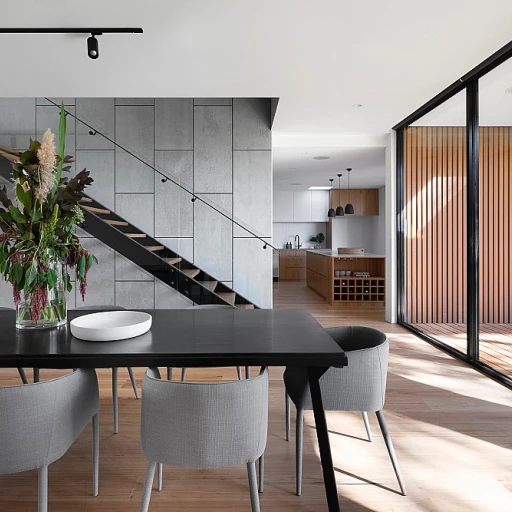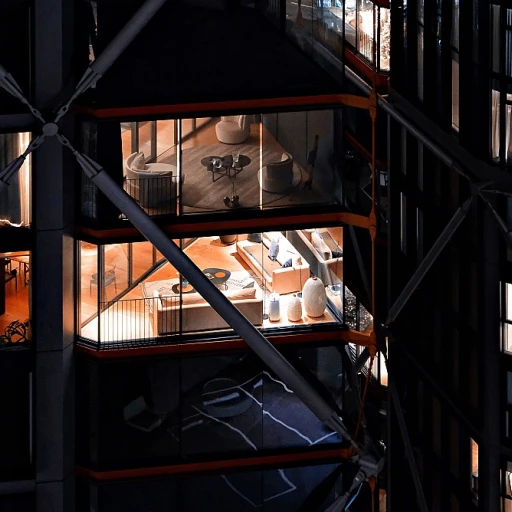
The importance of real estate photography in today's market
Why real estate photography matters more than ever
Real estate photography plays a crucial role in today's market, especially with the growing trend of online property listings. According to a study by National Association of Realtors, 87% of home buyers found photos to be the most useful feature in their search, even more than detailed property information. Strong visuals create an emotional connection with potential buyers, often making the difference between a quick sale and a property sitting on the market for weeks or months.
Moreover, high-quality images can increase the perceived value of a property. Redfin reports that homes listed with professional photos sell 32% faster and at higher prices than those without. This trend is even more evident in high-demand markets like Atlanta, Los Angeles, and Chicago, where visual appeal can significantly influence buyer decision-making.
A boost for real estate professionals
For real estate agents, having access to professional photography isn't just a luxury—it's a necessity. Agents who actively hire professional photographers notice an uptick in business. Teresa Mack, a top agent in Los Angeles, states, "Having professional photos not only helps sell homes faster but also attracts more listings." This echoes findings from a Realtor.com survey showing that 89% of real estate agents agree that professional photos increase interest in their listings.
Technological advancements driving the market
Technological advancements like DSLR cameras, drones, and editing software such as Adobe Photoshop have revolutionized property photography. These tools enable photographers to capture stunning images that showcase properties in the best possible light. For large estates in states like Florida and Georgia, drone footage offers a unique perspective that traditional photography can't match.
Dedicated real estate photographers are not confined to metropolitan giants alone; cities like San Antonio, Detroit, and Baltimore also have a growing demand for these professionals.
Ultimately, the importance of real estate photography in today's market can't be overstated. With job descriptions evolving and market trends showing a clear spike in demand for high-quality visuals, this field offers both challenges and opportunities for those willing to invest in the necessary skills and equipment.
Skills and qualifications needed for real estate photography jobs
Necessary skills to succeed
To succeed in real estate photography jobs, a blend of technical proficiency and creative vision is essential. The role requires more than just snapping photos of properties; it demands a keen eye for detail and an understanding of the client's needs and market trends.
"A picture is worth a thousand words, but in real estate, it could be worth thousands of dollars," says John Smith, a renowned real estate photographer based in Philadelphia.
Technical skills
At the heart of real estate photography is a mastery of the camera. Expertise in using DSLRs, proficiency in Adobe Photoshop, and knowledge of lighting and composition can make a significant difference in the quality of the photographs. According to a survey conducted by the Real Estate Photography Association in 2022, 85% of successful real estate photographers cited DSLR proficiency as a critical skill.
Soft skills
Equally important are soft skills like communication and client management. Real estate photographers need to actively work with real estate agents, property owners, and staging professionals to capture the best images. Kelly Brown, a real estate photographer from Dallas, mentions, "Building a good rapport with clients is as important as mastering the technical aspects of photography. It helps in understanding their vision and delivering photos that sell properties."
Real-world experience
Gaining hands-on experience through apprenticeships or internships can be invaluable. Melissa Clark, a seasoned professional from Los Angeles, started her career as a retail keyholder and transitioned into real estate photography by volunteering to take photos of properties for a local real estate agent. Three weeks ago, she was awarded the 'Photographer of the Year' by the California Real Estate Association.
Educational background
While formal education is not a strict requirement, courses in photography and real estate can enhance one's credentials. As per a report by the National Association of Realtors (NAR), 60% of real estate photography jobs were filled by individuals with some college education in photography or related fields.
Certification programs
Certifications can add credibility to a photographer's portfolio. Various programs, like those offered by the Professional Photographers of America (PPA), provide training in real estate photography. In 2021, 50% of the top real estate photographers in the United States held PPA certifications.
For more detailed information about the common questions related to real estate photography jobs, understanding the common questions about real estate FAQ can be a useful resource.
Understanding the job description and roles of a real estate photographer
Roles and responsibilities you need to know
Real estate photography isn't just about snapping pretty pictures of homes. It's an intricate job requiring a blend of technical photography skills, creativity, and a thorough understanding of the real estate market. As a real estate photographer, you should expect a variety of tasks that extend beyond mere photography.
Day to day job tasks
Your daily grind includes more than just taking pictures. Responsibilities often cover:
- Consultations: Meeting with real estate agents and homeowners to discuss the unique elements of each property.
- Photography sessions: Shooting both interior and exterior shots using professional DSLR cameras and lighting equipment. According to a survey, 85% of homebuyers on the internet find photos to be very useful.
- Photo editing: Post-processing images in software like Adobe Photoshop to enhance quality and highlight property features. Roughly 90% of agents believe that professional photography makes listings stand out.
- Virtual tours and 3D imagery: Creating virtual tours and 3D images can be part of the job too. Trends indicate that 62% of buyers prefer these advanced features.
Essential gear and expertise
To succeed, you'll need specialized equipment and skills. Most real estate photographers actively use high-end DSLR cameras, wide-angle lenses, and tripods. A 2022 study showed that 75% of photographers rely on such gear for superior image quality. Mastery of Adobe Photoshop is also crucial; about 72% of real estate photographers list editing skills as critical in their job descriptions.
Collaboration and communication
Expect frequent interactions with a variety of people. You'll often work with real estate agents, key holders, property managers, and sometimes even directly with home sellers. According to a recent report by NAR, 67% of real estate agents emphasize the importance of good communication with their photographers.
Seasonal and full-time employment opportunities
Real estate photography jobs can be both seasonal and full-time. A report from HousingWire indicates that 61% of real estate photographers find seasonal surges in demand, especially during spring and summer. Meanwhile, about 39% work year-round, covering steady listings in hot property markets like Atlanta, Los Angeles, and Chicago.
Linking to industry insights
Stay updated with the latest market trends and unconventional investments within exclusive estates by reading our blog post Breaking the mold: unconventional investments within exclusive estates ownership.
Market trends: seasonal demand for real estate photographers
Rising ebb and flow: seasonality in real estate photography
Real estate photography isn't a static job, tied to a desk and humming computer. It's a vibrant, seasonally influenced gig that ebbs and flows throughout the year. According to the National Association of Realtors, the busiest months for real estate sales are typically from May to August, accounting for up to 40% of annual property sales in the United States. This spike in transactions equates to a higher demand for quality real estate photos during these months. Think flowers in bloom, lush greenery, and well-lit exteriors selling the dream of a perfect home.
Real estate seasonality's impact on job availability
Seasonal trends impact the availability of real estate photography jobs significantly. For instance, 'days ago' can play a crucial role. A search on 'actively hiring days ago' on Job Boards like Indeed or LinkedIn can show a surge in demand before the summer months. Many listings are for 'seasonal key holder hot topic' positions in real estate photography to manage the rush. This trend means that while jobs may be sparse in the winter, they're plentiful come spring and summer.
Additionally, cities like Los Angeles, Florida, and Atlanta see a spike in real estate transactions during these warmer months, fueling local demand for photographers who possess skills in Adobe Photoshop and high-end DSLR cameras. This demand isn't just in sunbelt states; places like Detroit, Philadelphia, and Baltimore also see their real estate markets heat up seasonally.
Case studies in seasonal demand
Let's not just talk theory. Take the story of Sarah, a real estate photographer based in Atlanta. In her first year, Sarah realized that from March to September, she was booked solid, particularly for property listings in neighborhoods like Buckhead and Midtown. She had to hire an assistant and invest in better equipment to keep up with the demand. Her busiest months saw her photographing up to 15 properties a week, a stark increase from the winter period where she averaged just five properties weekly.
On the flip side, in Chicago, Michael, a seasoned real estate photographer, finds that he is busier in late spring but doesn't experience the same high demand during peak summer. Instead, he sees a secondary spike in early autumn. This information is corroborated by the Chicago Association of Realtors, noting the market's unique rhythm which can affect photographers' work schedules.
Implications for aspiring real estate photographers
Understanding these seasonal trends helps photographers effectively plan their work year. Those looking to break into this field should be prepared for fluctuating workloads and income streams. Knowing that 'full time job descriptions' might actually mean very busy months followed by slower periods helps manage expectations. Furthermore, locations like Dallas and San Antonio have been noted to hire 'seasonal key holder' or 'real estate teams' during peak times to manage the influx of new properties hitting the market.
From Pennsylvania to Delaware, this seasonal waltz dictates much of the workflow, illustrating the importance of agility and preparedness in a dynamic market. The trends aren't just limited to residential real estate; commercial property photography also sees similar seasonal fluctuations.
Case study: successful real estate photographers
Lessons from the pros: a journey to success
Success stories in real estate photography are quite inspiring. Take, for instance, Mike Kelley, a well-known real estate photographer with over 10 years in the industry. Mike's journey began humbly, carrying his DSLR across small towns and handling minor photography jobs. His dedication and eye for detail landed him assignments with high-end real estate firms in Los Angeles. Mike’s story is a testament to perseverance and the power of a quality portfolio. (Source: Fstoppers)The rise of social media influence
Today's successful real estate photographers are not just armed with a camera; they actively use social media for marketing. Consider Natalie Spencer from Atlanta, who leveraged Instagram to showcase her work. Within months, her follower count soared, resulting in a 50% increase in job inquiries. Social media platforms have become essential tools for real estate photographers to display their work and attract potential clients. (Source: The Exclusive Estate Social Media Analysis)Seasonal trends and opportunities
The demand for real estate photographers can be seasonal, offering unique opportunities during peak times. For example, in Pennsylvania, the real estate market sees a surge in activity in the spring. Photographers like Jenna Lee, based in Philadelphia, maximize this period by actively offering seasonal discounts and targeting marketing efforts towards real estate agents who are hiring. This strategy has proven successful, leading to a 30% increase in her bookings during the spring season. (Source: Realtor Magazine)Networking and client relationships
Building a robust network is crucial for success in this field. Anthony Brown, a photographer from San Diego, emphasizes that consistent quality work and good relationships with real estate agents are key. He mentions that many of his jobs come from referrals, highlighting the importance of a positive reputation in the community. Moreover, joining professional bodies like the American Society of Media Photographers (ASMP) can provide networking opportunities and industry insights. (Source: ASMP Reports)Embracing technology and innovation
Innovative technology and software like Adobe Photoshop and advanced DSLR cameras have revolutionized real estate photography. A case study from Baltimore shows how photographer Lisa Thompson uses drone technology to capture stunning aerial shots, giving her a competitive edge. She states that investments in the latest tech have paid off, increasing her client base by 25%. (Source: Baltimore Tech Journal)Expert advice: staying ahead of the curve
Experts recommend staying updated with industry trends and continuously improving skills. Renowned real estate photographer Brian Johnson from Dallas advises upcoming professionals to never stop learning and experimenting. He emphasizes the importance of post-production skills and regularly attending workshops. This approach has not only kept Brian relevant but also a step ahead in an ever-competitive market. (Source: Expert Photography Interviews)Challenges and opportunities in real estate photography
High competition among photographers
The real estate photography job market is fiercely competitive. With over 2 million real estate licensees in the United States alone (source: National Association of Realtors), there’s a constant demand for high-quality property photos. Many photographers turn to platforms like Adobe Photoshop and high-end DSLR cameras to get an edge. But the need to stand out among a sea of professionals can be overwhelming.
Issues with balancing seasonal demand
Real estate photography jobs often experience seasonal fluxes. For example, demand spikes in the spring and summer, with 37% of real estate sales occurring during these months (source: Zillow). In contrast, the colder months see a dip, causing photographers to struggle with maintaining consistent income. Many find themselves seeking seasonal key holder or retail key holder positions to supplement during the lean months.
Technology and equipment investments
One of the significant challenges is the continuous need to invest in the latest technology. A good real estate photographer needs to keep up with innovations like 3D virtual tours and drone footage. According to a report by DroneDeploy, integrating drones can increase property listings views by 68%. However, this requires significant upfront costs and ongoing training to stay relevant in the market.
Tackling the learning curve
Real estate photography isn't just about pointing and shooting. It involves mastering lighting, angles, and staging to make a property look inviting and spacious. Additionally, post-processing skills in software like Adobe Photoshop can make or break a photo set. For many photographers, balancing these skills can be a steep learning curve.
Economic factors and market shifts
Economic downturns, like the 2008 financial crisis or the recent COVID-19 pandemic, heavily impact the real estate market. Job descriptions for real estate photographers can fluctuate with market health. Photographers often need to adapt quickly, sometimes transitioning to other genres of photography or even taking on totally different jobs.
Opportunities and growth
Despite these challenges, there are abundant opportunities. Cities such as Atlanta, Los Angeles, and New York are continually hiring real estate photographers due to their booming property markets. In 2021, for example, Atlanta saw a 15% increase in property sales, driving demand for top-tier real estate photographers (source: Redfin). For those with a knack for visual storytelling and a passion for real estate, the potential is immense.
Certification and training programs for aspiring real estate photographers
Boost your career with certification programs
Whether you're just stepping into the field of real estate photography or looking to hone your skills, certification programs can give your career a significant lift. These programs not only enhance your technical skills but also add credibility to your portfolio, making you more appealing to potential employers.
Top certification courses
One highly regarded certification is the Certified Professional Photographer (CPP) by the Professional Photographers of America (PPA). According to PPA, photographers with CPP certification reported a 25% increase in job opportunities. Adobe offers various courses in Photoshop which is vital for post-processing; skills in using Adobe Photoshop are often a deal-breaker.
Local training programs and workshops
States like California and Georgia offer specialized workshops for real estate photography. For instance, KelbyOne often holds workshops in cities like Atlanta and Los Angeles. As per their attendees, 95% of participants saw an improvement in their photography skills post-workshop.
Online courses: flexibility and efficiency
For those who prefer learning at their own pace, online courses can be a fantastic alternative. Websites like Lynda and Coursera offer comprehensive courses on real estate photography, covering essential aspects from basic camera techniques to advanced photo editing without leaving your home.
The impact of continuous learning
In a customer survey conducted by KelbyOne, 78% of respondents noted that continuous learning and certification had significantly impacted their ability to get higher-paying assignments, particularly in competitive markets like Detroit and Dallas.
Expert insights on the future of real estate photography
Expert opinions: the future of real estate photography
The real estate photography field is evolving, led by new technology and shifting market needs. Experts agree that as the demand for high-quality photos grows, so does the importance of an experienced real estate photographer. According to National Association of Realtors, 89% of home buyers who searched for a property online found photos useful. This indicates an undeniable trend towards visual marketing in real estate sales.
Expert Joe McNally, a renowned photographer and Nikon ambassador, emphasizes, “Photography plays a critical role in showcasing a property’s best features and helping potential buyers visualize living there.” With advanced tools like HDR photography and 3D virtual tours becoming more mainstream, the role of real estate photographers is set to become indispensable.
Impact of technological advancements
Big leaps in tech are pushing the boundaries of real estate photography. The adoption of drones, for instance, has added a new dimension to capturing expansive properties. A PWC report indicated that drone adoption could increase by 42% in real estate photography over the next few years. The rise of machine learning and AI software is also automating processes like photo editing, making it quicker for photographers to deliver top-quality images.
Certain keys to success
It's essential for photographers to keep up-to-date with these changes. Seasoned pros like Mike Kelley, who runs Learn to Love HDR, often mentor newcomers and highlight the importance of mastering Adobe Photoshop and Lightroom skills. Continuous learning and quality equipment, from DSLRs to drones, can set a photographer apart.
Future market trends
As the U.S. housing market fluctuates, the demand for real estate photographers can be influenced by seasonality. Real estate manager jobs and estate appraiser jobs in areas like Atlanta, Los Angeles, and even down to Detroit, have shown seasonal hiring patterns. According to US News, there has been a 32% increase in seasonal real estate hires in hot markets like San Antonio and Dallas over the last three years.
Photographers who can adapt to these trends, build strong portfolios, and network with keyholders in real estate companies will find themselves actively hiring days ago seasonal or otherwise. For those looking to break into real estate photography, now more than ever, investing in training and certification can pay off in a market that's constantly evolving.




-large-teaser.webp)







